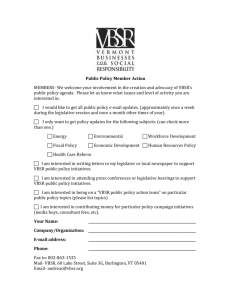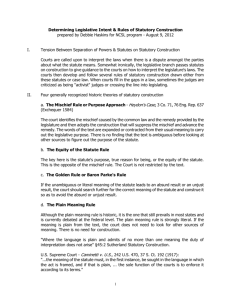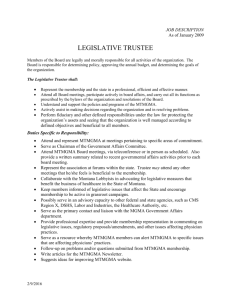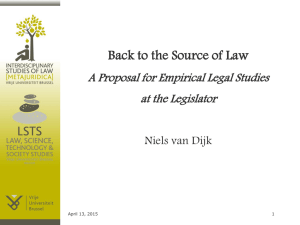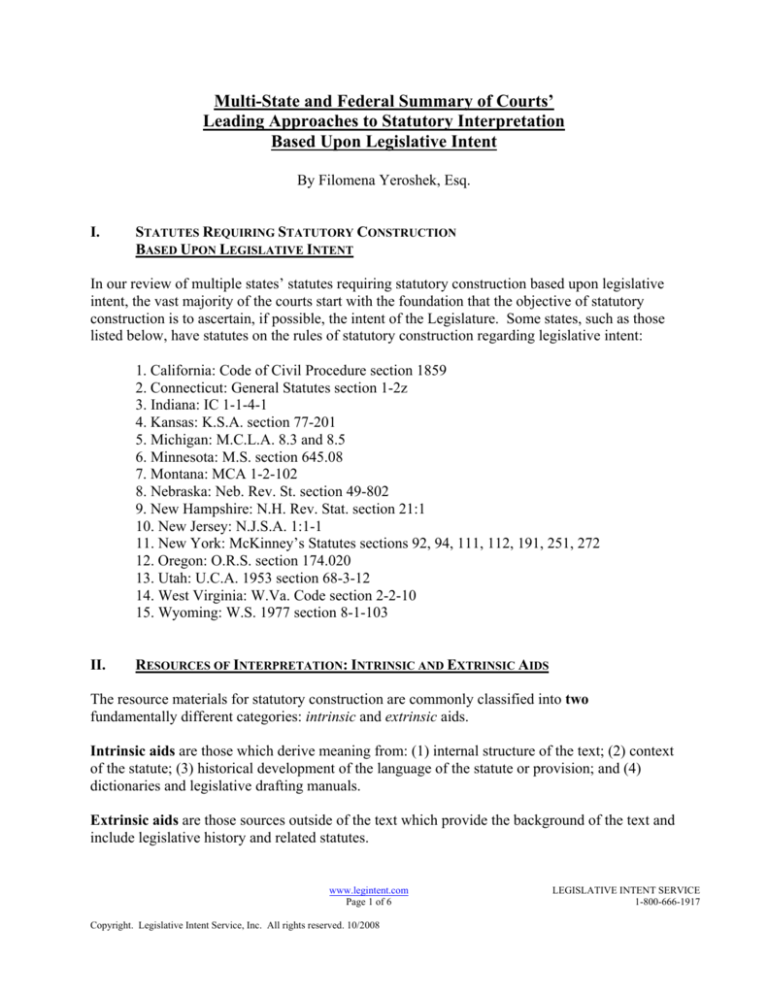
Multi-State and Federal Summary of Courts’
Leading Approaches to Statutory Interpretation
Based Upon Legislative Intent
By Filomena Yeroshek, Esq.
I.
STATUTES REQUIRING STATUTORY CONSTRUCTION
BASED UPON LEGISLATIVE INTENT
In our review of multiple states’ statutes requiring statutory construction based upon legislative
intent, the vast majority of the courts start with the foundation that the objective of statutory
construction is to ascertain, if possible, the intent of the Legislature. Some states, such as those
listed below, have statutes on the rules of statutory construction regarding legislative intent:
1. California: Code of Civil Procedure section 1859
2. Connecticut: General Statutes section 1-2z
3. Indiana: IC 1-1-4-1
4. Kansas: K.S.A. section 77-201
5. Michigan: M.C.L.A. 8.3 and 8.5
6. Minnesota: M.S. section 645.08
7. Montana: MCA 1-2-102
8. Nebraska: Neb. Rev. St. section 49-802
9. New Hampshire: N.H. Rev. Stat. section 21:1
10. New Jersey: N.J.S.A. 1:1-1
11. New York: McKinney’s Statutes sections 92, 94, 111, 112, 191, 251, 272
12. Oregon: O.R.S. section 174.020
13. Utah: U.C.A. 1953 section 68-3-12
14. West Virginia: W.Va. Code section 2-2-10
15. Wyoming: W.S. 1977 section 8-1-103
II.
RESOURCES OF INTERPRETATION: INTRINSIC AND EXTRINSIC AIDS
The resource materials for statutory construction are commonly classified into two
fundamentally different categories: intrinsic and extrinsic aids.
Intrinsic aids are those which derive meaning from: (1) internal structure of the text; (2) context
of the statute; (3) historical development of the language of the statute or provision; and (4)
dictionaries and legislative drafting manuals.
Extrinsic aids are those sources outside of the text which provide the background of the text and
include legislative history and related statutes.
www.legintent.com
Page 1 of 6
Copyright. Legislative Intent Service, Inc. All rights reserved. 10/2008
LEGISLATIVE INTENT SERVICE
1-800-666-1917
III.
CONTINUUM OF APPROACHES IN DECIPHERING LEGISLATIVE INTENT
There is a continuum of approaches courts take in attempting to decipher statutory intent. All of
these approaches start with the foundation that the primary goal is to discern and give effect to
legislative intent. Regardless of whether the state has or does not have a statute providing a
structure or method of interpretation, in our sample states we found all courts begin, or at least
mention, looking at the text of the statute as a starting point. This approach is often described as
the plain meaning rule. The plain meaning rule provides that if the statute is plain and
unambiguous courts need not look beyond the text to ascertain the intent of the legislature; courts
must give effect to that plain meaning as an expression of legislative intent.
State courts’ approaches to applying the plain meaning rule in statutory interpretation is
necessarily described as existing along a continuum due to the lack of uniformity in the
application of the rule as the courts struggle to decipher legislative intent. One of the difficult
issues in trying to define these approaches and determine which states use which approach is that
the approaches are not exclusive and the same courts use different approaches on this continuum
in different cases. The individual case appears to highly influence the approach taken: the facts
of the case, the legal theories advocated, and the case precedent all play a role.
A. New Textualism or Strict Plain Meaning
The New Textualism approach follows the theory that once the court has ascertained a statute’s
plain meaning, consideration of legislative history becomes irrelevant.
This approach uses only intrinsic aids in determining whether the text has a plain meaning.
Dictionary definitions, and some previously thought of as archaic, canons of statutory
interpretation, grammar, language use, and punctuation are used extensively with this approach.
In addition, the court considers how the word or phrase is used elsewhere in the same statute or
how it is used in other statutes. (Pierce v. Underwood, 487 U.S. 552 (1988)) The court may
consider how the possible meanings fit with the statute as a whole. For example, does one
meaning render other provisions duplicative or superfluous? (United States v. Fausto, 484 U.S.
439 (1988)) The court may also rely on the interaction of different statutory schemes to
determine statutory plain meaning. (Jett v. Dallas Independent School District, 491 U.S. 701
(1989))
Under the New Textualism approach, extrinsic aids, such as the legislative history, are rarely
examined in determining legislative intent because there must first be a determination of
ambiguity. A recent Michigan Supreme Court opinion concisely summarized the New
Textualism’s view of ambiguity, stating, “only a few provisions are truly ambiguous and a
diligent application of the rules of interpretation will yield a ‘better,’ albeit perhaps imperfect,
interpretation of the law.” (People v. Gardner, 482 Mich. 41, fn. 12, 753 N.W.2d 78 (2008))
www.legintent.com
Page 2 of 6
Copyright. Legislative Intent Service, Inc. All rights reserved. 10/2008
LEGISLATIVE INTENT SERVICE
1-800-666-1917
However, in the very rare cases where the plain meaning of the language would result in a patent
absurdity legislative history may be reviewed. (Green v. Bock Laundry Machine Co. 409 U.S.
504, 527 (1989))
New Textualism is associated with Supreme Court Justice Anthony Scalia and is followed by a
small minority of states. Of the random sample of states reviewed, only a few recent Michigan
Supreme Court cases used this new textualism approach. (e. g. People v. Gardner, 482 Mich. 41,
fn. 12, 753 N.W.2d 78 (2008); Bukowski v. City of Detroit, 478 Mich. 268, 732 N.W. 2d 75
(2007))
B. Plain Meaning Based on Language Alone
One of the traditional plain meaning approaches starts with the premise that the “best and most
reliable index of the statute’s meaning is the language itself.” Plain meaning is discerned from
the ordinary meaning of the language at issue. Consideration of statutory scheme, as a whole,
or related statutes is part of the inquiry into the legislative intent only if the court determines that
the plain meaning cannot be derived from the statutory provision at issue and ambiguity
necessitates further inquiry.
At first glance this approach sounds like New Textualism; however, there is a fundamental
difference in the determination of whether language is plain or ambiguous which thus opens the
door to use extrinsic aids as part of the legislative intent analysis.
C. Plain Meaning Based on
Language, Statutory Scheme, and Related Statutes
Another approach in this continuum examines the language of the word, phrase, or provision as
well as the amendments (i.e. historical development) of the statute in which the provision at issue
is found. The courts also look at the relationship of the statute with other related statutes or other
provisions of the same act in which the provision is found, as part of the determination of
whether a plain meaning can be ascertained. (e.g. Arizona, California, Connecticut, Utah,
Washington, Wisconsin)
This approach uses both intrinsic and limited extrinsic aids in the plain meaning analysis. The
courts use the typical intrinsic aids such as internal structure of the text; the context of the statute
or statutory scheme; the historical development of the language of the statute or provision; and
dictionaries and legislative drafting manuals. One of the differences in this approach is the
examination of related statutes, which is considered an extrinsic aid, in the initial determination
of ambiguity or plain meaning.
www.legintent.com
Page 3 of 6
Copyright. Legislative Intent Service, Inc. All rights reserved. 10/2008
LEGISLATIVE INTENT SERVICE
1-800-666-1917
The Washington State Supreme Court explained this approach, stating:
In the past, the plain meaning rule rested on theories of language and meaning,
now discredited, which held that words have inherent or fixed meanings. These
theories are unnecessary to the plain meaning rule, however, if the rule is
interpreted to direct a court to construe and apply words according to the meaning
that they are ordinarily given, taking into account the statutory context, basic rules
of grammar, and any special usages stated by the legislation on the face of the
statute. So defined, the plain meaning rule requires courts to consider legislative
purposes or policies appearing on the face of the statute as part of the statute’s
context. In addition, background facts of which judicial notice can be taken are
properly considered as part of the statute’s context because presumably the
legislature also was familiar with them when it passed the statute. Reference to a
statute’s context to determine its plain meaning also included examining closely
related statutes, because legislators enact legislation in light of existing statutes.
…
Under this second approach, the plain meaning is still derived from what the
Legislature has said in its enactments, but that meaning is discerned from all that
the Legislature has said in the statute and related statutes which disclose
legislative intent about the provision in question. Upon reflection, we conclude
that this information of the plain meaning rule provides the better approach
because it is more likely to carry out the legislative intent….
(Department of Ecology v. Campbell & Gwinn, L.L.C., 146 Wash.2d 1, 10, 43
P.3d 11, 12 (2002)
D. Plain Meaning Based on a “Holistic” Approach
Supreme Court Justice Ginsburg in the Koons Buick case stated that “statutory construction is a
‘holistic’ endeavor.” (Koons Buick Pontiac GMC, Inc. v. Nigh, 543 U.S. 50, 60 (2004)) Justice
Ginsburg explained that, “[A] provision that may seem ambiguous in isolation is often clarified
by the remainder of statutory scheme – because the same terminology is used elsewhere in a
context that makes its meaning clear, or because only one of the permissible meanings produces
a substantive effect that is compatible with the rest of the law.” (Id.) As part of this “holistic
endeavor” the Court looked at: (1) the text of the provision; (2) the statutory history; (3) the
legislative history; and (4) common sense. (Id. at pages 60 through 64)
The Arizona Supreme Court concisely summarized this approach, stating:
Our primary goal is to “discern and give effect to legislative intent.”
[citations omitted] “We construe the statute as a whole and consider its context,
language, subject matter, historical background, effects and consequences, [and]
its spirit and purpose.” [citation omitted] We construe related statutes together,
www.legintent.com
Page 4 of 6
Copyright. Legislative Intent Service, Inc. All rights reserved. 10/2008
LEGISLATIVE INTENT SERVICE
1-800-666-1917
[citation omitted] and avoid interpretations that render statutory provisions
meaningless, unnecessary, or duplicative… [citation omitted]
(Arizona Dept of Revenue v. Action Marine, Inc, 218 Ariz. 141, 181 P.3d 188, 190
(2008))
States such as Arizona, California, Kansas, Utah, and Wisconsin, to name just a few, seem to use
a similar holistic and dynamic approach to statutory construction and the plain meaning rule.
This holistic approach does not find it inconsistent to review both the plain meaning of the
language and the legislative history of the enactment, regardless of the existence of an ambiguity.
Courts using this approach often perform an intrinsic analysis of the plain meaning of the
statutory language and whether or not the courts found an ambiguity in the statutory language,
they will review extrinsic aids such as legislative history to support, buttress, validate, and
confirm the court’s interpretation.
An example of this approach is set forth in a California Supreme Court opinion as follows:
Our first task is to examine the language of the statute enacted ...
giving the words their usual, ordinary meaning. [citations omitted] If the
language is clear and unambiguous, we follow the plain meaning of the
measure. [citations omitted] "[T]he ‘plain meaning’ rule does not prohibit a
court from determining whether the literal meaning of a measure comports
with its purpose...." [citation omitted]
... It is appropriate to consider evidence of the intent of the enacting
body in addition to the words of the measure, and to examine the history and
background of the provision in an attempt to ascertain the most reasonable
interpretation. [citations omitted]
(People v. Canty, 32 Cal.4th 1266, 1276-1277, 90 P.3d 1168 (2004))
Another example is found in a recent Utah Supreme Court case in which the court stated:
Although we conclude that the statue is clear on its face, thereby rendering
examination of legislative history unnecessary, it is worth noting that the
legislative history of … which was codified as … is consistent with our
conclusion.
(Emergency Physicians Integrated Care v. Salt Lake County, 167 P.3d 1080
(Utah, 2007))
A majority of the sample states researched followed the above approach, stating that the court’s
plain meaning interpretation was “buttressed,” “supported,” “consistent with,” or “verified” by
the legislative history of the statute. (See, e.g. State v. Leenhouts, 218 Ariz. 346, 185 P.3d 132
(2008); Sands v. Whitnall School Dist., 754 N.W.2d 439 (Wis. 2008); State v. Anderson, 281
Kan. 896, 136 P.3d 406 (2006); Trendwest Resorts, Inc. v. Department of Revenue, 340 Or. 413,
www.legintent.com
Page 5 of 6
Copyright. Legislative Intent Service, Inc. All rights reserved. 10/2008
LEGISLATIVE INTENT SERVICE
1-800-666-1917
134 P.3d 932 (2006); Wells v. One2One Learning Foundation, 39 Cal.4th 1164, 141 P.3d 225
(2006))
IV.
AMBIGUITY DEFINED
Regardless of where on the continuum a court falls in its consideration of legislative intent, a key
element to consider is how that jurisdiction defines ambiguity. Whether extrinsic aids, such as
legislative history, are examined may hinge on whether the word, phrase, provision, or statute is
ambiguous. There is a broad range of definitions of ambiguity. In reviewing hundreds of state
supreme court cases it seems clear that the broader the definition of ambiguous the more
“holistic” or dynamic the court’s approach is to legislative interpretation.
For example, a recent Michigan Supreme Court case, which followed the New Textualism
approach, defined ambiguity as follows:
A provision is not ambiguous just because “reasonable minds can differ regarding
the meaning of the provision. [citation] Rather, a provision of the law is
ambiguous only if it “irreconcilably conflicts with another provision, or when it is
equally susceptible to more than a single meaning.
(People v. Gardner, 482 Mich. 41, 753 N.W.2d 78, 85 (Mich. 2008))
On the other hand, the Utah Supreme Court has defined ambiguous to be where text is
“susceptible to two interpretations” (Bluffdale Mountain Homes, LC v. Bluffdale City, 167 P.3d
1016 (Utah 2006)) or “duplicative, yet plausible meanings are not eliminated from possibility”
(Martinez v. Media-Paymaster Plus/Church of Jesus Christ of Later-Day Saints, 164 P.3d 384
(Utah 2007)). In addition, statutory language was found ambiguous because it gave “rise to
several plausible interpretations.” (Utah Public Employees Ass’n v. State, 131 P.3d 208 (Utah
2008)
Ambiguity was defined by the Arizona Supreme Court as “when uncertainty exists about the
meaning or interpretation of a provision’s terms.” (Heath v. Keger, 217 Ariz. 492, 176 P.3d 690
(2008))
The Wisconsin Supreme Court in a recent opinion concisely put into context the importance of
defining “ambiguity” stating:
… If a statute is ambiguous, i.e., capable of being understood in more than one
way by reasonably well-informed persons, the court may examine external
sources such as legislative history to determine the statute's meaning. [citation]
However, the court may also consult extrinsic sources “to confirm or verify a
plain-meaning interpretation.”
(Sands v. Whitnall School Dist., 754 N.W.2d 439 (Wis. 2008))
www.legintent.com
Page 6 of 6
Copyright. Legislative Intent Service, Inc. All rights reserved. 10/2008
LEGISLATIVE INTENT SERVICE
1-800-666-1917

